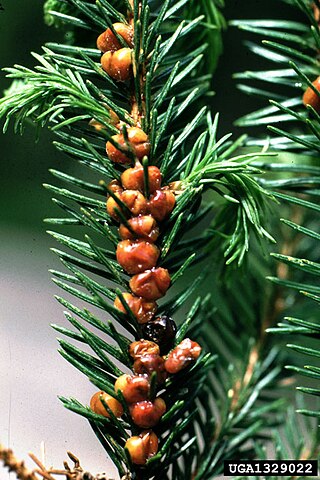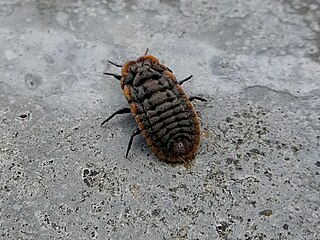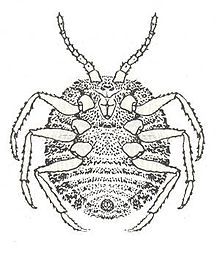
Mealybugs are insects in the family Pseudococcidae, unarmored scale insects found in moist, warm habitats. Of the more than 2,000 described species, many are considered pests as they feed on plant juices of greenhouse plants, house plants and subtropical trees and also act as a vector for several plant diseases. Some ants live in symbiotic relationships with them, protecting them from predators and feeding off the honeydew which they excrete.

Aspidiotus is a genus of armoured scales in the family Diaspididae. There are more than 100 described species in Aspidiotus.
Carayonemidae is a family of scale insects commonly known as carayonemids. They typically live among mosses and leaf litter which is unusual for scale insects. Members of this family come from Neotropical areas of South and Central America.

Ortheziidae is a family of scale insects commonly known as the ensign scales or ortheziids. They occur in most parts of the world but the majority of the species are found in the Neotropical and Nearctic regions while there are not many species in Australasia and the Far East. There are twenty valid genera and 198 species.
Newsteadia is a genus of ensign scale insects in the superfamily Coccoidea. Most species are inconspicuous, measuring under two millimeters long and found in leaf litter.

Aulacaspis, is a scale insect genus in the family Diaspididae. The type species is Aulacaspis rosae.

Lepidosaphidini is a tribe of armored scale insects.

Chionaspis is a genus of scale insect. In 2011 geographical sampling and analysis indicated a number of unnamed species in the genus Chionaspis.

Lepidosaphes is a genus of armored scale insects in the family Diaspididae. There are at least 190 described species in Lepidosaphes, found worldwide.

Pseudaulacaspis is a genus of scales and mealybugs in the family Diaspididae. There are at least 60 described species in Pseudaulacaspis.

Physokermes are a genus of scale insects known as the bud scales. They are restricted to the Holarctic, though Physokermes hemicryphus has been introduced to North America. Some species are plant pests.
Newsteadia floccosa, the boreal ensign scale, is a species of scale insect in the family Ortheziidae. It is native to Europe and is found in the soil and amongst plant litter and mosses on the ground.

Diaspidiotus is a genus of armoured scales in the family Diaspididae. There are more than 90 described species in Diaspidiotus, found worldwide.

Eulecanium is a genus of true bugs belonging to the family Coccidae.

Drosicha is a genus of true bugs belonging to the family Monophlebidae. The species of this genus are found in Eurasia.

Orthezia urticae is a species of scale insect in the family Ortheziidae.

Eriococcus is the type genus of scale insects in the family Eriococcidae, erected by Targioni-Tozzetti in 1868. Species records have a world-wide distribution, but this genus name is known to be polyphyletic, so species placement is subject to change.

Crypticerya is a genus of scale insects belonging to the family Monophlebidae. When the genus was revived in 2008, it included 22 species, all found in the Americas. As of 2024, there are 28 described species.














